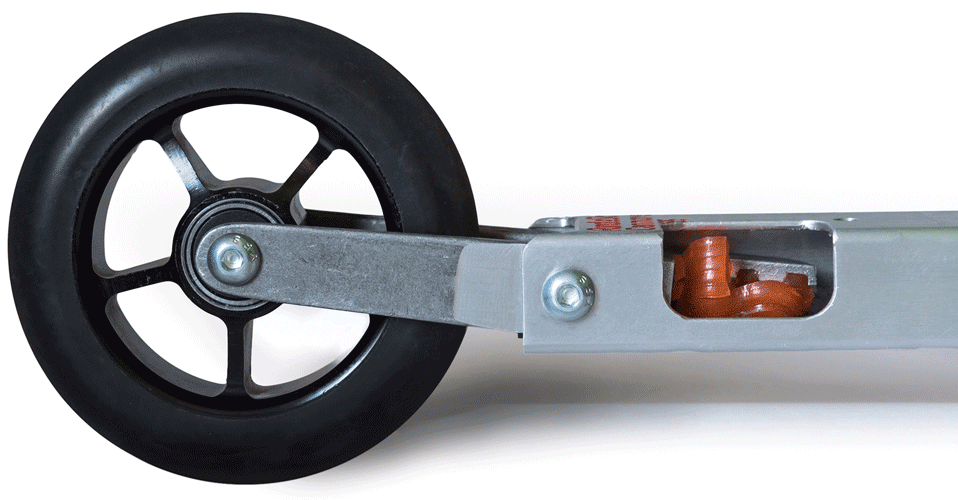
…Once upon a time, in a different era when humans were living without the Internet, each country that had snow and, therefore, skiers, was also producing its own, domestic rollerskis. That gave rise to very distinct schools of rollerski design e.g. the Italians were/are famous for speed & competition ones, the Norwegians and the Finns – for “slow skis” well suited for long training sessions. Hidden away from sight, across the ocean a North American school of rollerski design had developed – with its own distinct features.
Unlike the European producers who experiment a lot with actual materials – be it carbon or carbon-laminated frames and proprietary composition wheels – the North Americans tend to use time-tested solutions such as milled aluminum frames – but add rather intricate engineering to achieve that ultimate ‘ski feel’ of which all the rollerski producers, without exception, speak.
A Canadian rollerski design & production shop Rundle Sport is a good example. Founded in 2013, Rundle Sport is a newcomer on the market that is dominated by legacy companies with decades of history.
To break into market as traditional as rollerski, the new entrant needs to offer something new – and fairly radically new for that. And it looks like that the Canadians do.
Here’s the Rundle’s flagship FLEX™ Skate rollerskis that incorporate the latest and the best of what the North American design & development school has to offer.
https://www.instagram.com/p/BTCqlFfgxhc
The key feature of FLEX is the company’s patented TrueSki™ technology that incorporates a proprietary suspension system. FLEX roller skis use rubber suspension dampers that come in 5 different stiffnesses and can be changed with nothing more than a 4mm hex key. The idea is is, when and if skier’s weight changes (like with growing kids – or formerly overweight middle aged men who sweated out that extra belly fat layer doing rollerskiing) the roller skis can be re-tuned to the skier’s weight by installing new dampers. According to producer, the range is from 49kg to virtual infinity.

Apart from convenience of use, TrueSki – Rundle says – does three other things: reduces vibration, mimics snow skis, increases durability.
We were not yet able to test the new Rundle FLEX so don’t really have our own opinion on either vibration reduction or ski mimicking claims – but Internet forums praise Rundle FLEX for both.
As to durability increase – that assertion is hotly contested by a least two European producers that we have spoken to, who claim that fancy suspensions adversely affect the longevity of rollerskis (NB: in principle – Rundle FLEX was not mentioned specifically). Again, the jury is still out on that.
What can not be denied is the location advantage Rundle has: the company is based in Canmore, where the cross-counry skiing races of the 1988 Olympics were held and which remains one the top skiing centers in North America ( Rundle is named after Mount Rundle overlooking the town of Canmore)
Says Patrick McCarter, Marketing Manager of Rundle Sport
“Having a strong athlete team is essential because it allows a lot of testing to be done quickly and you get immediate feedback. Our in-house CNC (Computer numerical control) machine combined with half of our athlete team living less than 5 minutes from Rundle Sport headquarters gives us one of the most efficient testing processes of any roller ski company”
https://www.instagram.com/p/BWAzJAnBYVb
Another distinct feature of Rundle philosophy is the market they target.
” …we realized we needed to listen to feedback from both amateur and world cuplevel athletes when evaluating how to improve 2016 FLEX roller skis. We want our roller skis to suit all athletes, and in many ways amateur skiers are more sensitive to things that need improvement. The biggest improvement
we made to FLEX roller skis was increased stability, but this change was
primarily requested by coaches, customers, and young athletes. Our highest
performing athletes weren’t as focused on stability because they’re very
coordinated, balanced, and physically strong”
The North American rollerski market is still tiny. To sale in volume, one needs to conquer Europe. And that’s where the new Internet era comes into play – the Canadians are way ahead of the European competitors on design of their sleek website – offering online payment and delivery to virtually any country in the world ( altough you’d be well advised to check import taxes situation and VAT rules in your country before ordering anything overseas. It’s not difficult or complicated – just adds to the costs)
We here at the Daily Skier think it’s great that markets are becoming more open and true competition between different national/regional schools of rollerski design develops. The more choice – the better.
https://www.instagram.com/p/BWdqDjcBGdj
